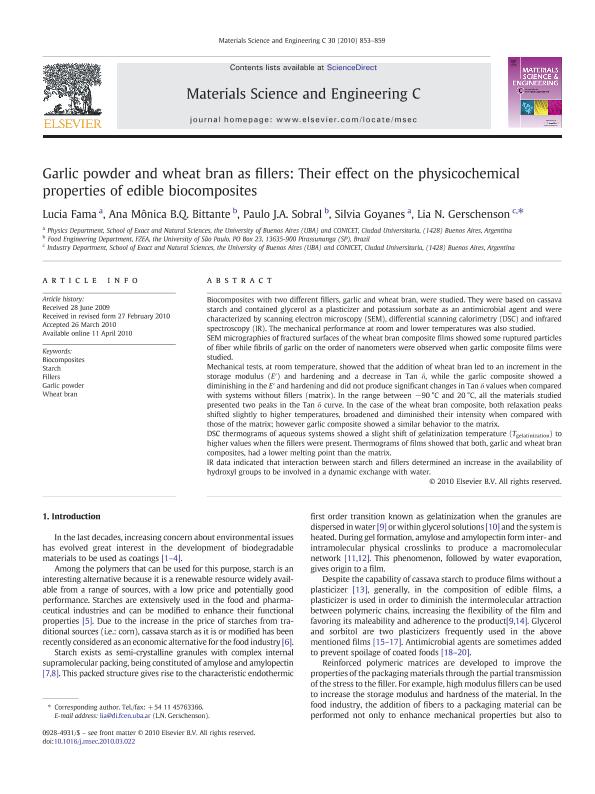Artículo
Garlic powder and wheat bran as fillers: Their effect on the physicochemical properties of edible biocomposites
Fama, Lucia Mercedes ; Bittante, Ana Mônica B. Q.; Sobral, Paulo J. A.; Goyanes, Silvia Nair
; Bittante, Ana Mônica B. Q.; Sobral, Paulo J. A.; Goyanes, Silvia Nair ; Gerschenson, Lia Noemi
; Gerschenson, Lia Noemi
 ; Bittante, Ana Mônica B. Q.; Sobral, Paulo J. A.; Goyanes, Silvia Nair
; Bittante, Ana Mônica B. Q.; Sobral, Paulo J. A.; Goyanes, Silvia Nair ; Gerschenson, Lia Noemi
; Gerschenson, Lia Noemi
Fecha de publicación:
07/2010
Editorial:
Elsevier Science
Revista:
Materials Science and Engineering: C
ISSN:
0928-4931
Idioma:
Inglés
Tipo de recurso:
Artículo publicado
Clasificación temática:
Resumen
Biocomposites with two different fillers, garlic and wheat bran, were studied. They were based on cassava starch and contained glycerol as a plasticizer and potassium sorbate as an antimicrobial agent and were characterized by scanning electron microscopy (SEM), differential scanning calorimetry (DSC) and infrared spectroscopy (IR). The mechanical performance at room and lower temperatures was also studied. SEM micrographies of fractured surfaces of the wheat bran composite films showed some ruptured particles of fiber while fibrils of garlic on the order of nanometers were observed when garlic composite films were studied. Mechanical tests, at room temperature, showed that the addition of wheat bran led to an increment in the storage modulus (E′) and hardening and a decrease in Tan δ, while the garlic composite showed a diminishing in the E′ and hardening and did not produce significant changes in Tan δ values when compared with systems without fillers (matrix). In the range between -90 °C and 20 °C, all the materials studied presented two peaks in the Tan δ curve. In the case of the wheat bran composite, both relaxation peaks shifted slightly to higher temperatures, broadened and diminished their intensity when compared with those of the matrix; however garlic composite showed a similar behavior to the matrix. DSC thermograms of aqueous systems showed a slight shift of gelatinization temperature (Tgelatinization) to higher values when the fillers were present. Thermograms of films showed that both, garlic and wheat bran composites, had a lower melting point than the matrix. IR data indicated that interaction between starch and fillers determined an increase in the availability of hydroxyl groups to be involved in a dynamic exchange with water.
Palabras clave:
Biocomposites
,
Fillers
,
Garlic Powder
,
Starch
,
Wheat Bran
Archivos asociados
Licencia
Identificadores
Colecciones
Articulos(IFIBA)
Articulos de INST.DE FISICA DE BUENOS AIRES
Articulos de INST.DE FISICA DE BUENOS AIRES
Articulos(INTECIN)
Articulos de INST.D/TEC.Y CS.DE LA ING."HILARIO FERNANDEZ LONG"
Articulos de INST.D/TEC.Y CS.DE LA ING."HILARIO FERNANDEZ LONG"
Articulos(OCA CIUDAD UNIVERSITARIA)
Articulos de OFICINA DE COORDINACION ADMINISTRATIVA CIUDAD UNIVERSITARIA
Articulos de OFICINA DE COORDINACION ADMINISTRATIVA CIUDAD UNIVERSITARIA
Citación
Fama, Lucia Mercedes; Bittante, Ana Mônica B. Q.; Sobral, Paulo J. A.; Goyanes, Silvia Nair; Gerschenson, Lia Noemi; Garlic powder and wheat bran as fillers: Their effect on the physicochemical properties of edible biocomposites; Elsevier Science; Materials Science and Engineering: C; 30; 6; 7-2010; 853-859
Compartir
Altmétricas



